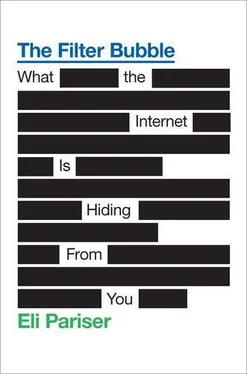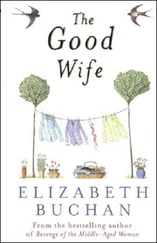As a result, while the Internet offers access to a dazzling array of sources and options, in the filter bubble we’ll miss many of them. While the Internet can give us new opportunities to grow and experiment with our identities, the economics of personalization push toward a static conception of personhood. While the Internet has the potential to decentralize knowledge and control, in practice it’s concentrating control over what we see and what opportunities we’re offered in the hands of fewer people than ever before.
Of course, there are some advantages to the rise of the personalized Internet. I enjoy using Pandora, Netflix, and Facebook as much as the next person. I appreciate Google’s shortcuts through the information jungle (and couldn’t have written this book without them). But what’s troubling about this shift toward personalization is that it’s largely invisible to users and, as a result, out of our control. We are not even aware that we’re seeing increasingly divergent images of the Internet. The Internet may know who we are, but we don’t know who it thinks we are or how it’s using that information. Technology designed to give us more control over our lives is actually taking control away.
Ultimately, Sun Microsystems cofounder Bill Joy told me, information systems have to be judged on their public outcomes. “If what the Internet does is spread around a lot of information, fine, but what did that cause to happen?” he asked. If it’s not helping us solve the really big problems, what good is it? “We really need to address the core issues: climate change, political instability in Asia and the Middle East, demographic problems, and the decline of the middle class. In the context of problems of this magnitude, you’d hope that a new constituency would emerge, but there’s a distraction overlay—false issues, entertainment, gaming. If our system, with all the freedom of choice, is not addressing the problems, something’s wrong.”
Something is wrong with our media. But the Internet isn’t doomed, for a simple reason: This new medium is nothing if not plastic. Its great strength, in fact, is its capacity for change. Through a combination of individual action, corporate responsibility, and governmental regulation, it’s still possible to shift course.
“We create the Web,” Sir Tim Berners-Lee wrote. “We choose what properties we want it to have and not have. It is by no means finished (and it’s certainly not dead).” It’s still possible to build information systems that introduce us to new ideas, that push us in new ways. It’s still possible to create media that show us what we don’t know, rather than reflecting what we do. It’s still possible to erect systems that don’t trap us in an endless loop of self-flattery about our own interests or shield us from fields of inquiry that aren’t our own.
First, however, we need a vision—a sense of what to aim for.
The Mosaic of Subcultures
In 1975, architect Christopher Alexander and a team of colleagues began publishing a series of books that would change the face of urban planning, design, and programming. The most famous volume, A Pattern Language, is a guidebook that reads like a religious text. It’s filled with quotes and aphorisms and hand-drawn sketches, a bible guiding devotees toward a new way of thinking about the world.
The question that had consumed Alexander and his team during eight years of research was the question of why some places thrived and “worked” while others didn’t—why some cities and neighborhoods and houses flourished, while others were grim and desolate. The key, Alexander argued, was that design has to fit its literal and cultural context. And the best way to ensure that, they concluded, was to use a “pattern language,” a set of design specifications for human spaces.
Even for nonarchitects, the book is an entrancing read. There’s a pattern that describes the ideal nook for kids (the ceiling should be between 2 feet 6 inches and 4 feet high), and another for High Places “where you can look down and survey your world.” “Every society which is alive and whole,” Alexander wrote, “will have its own unique and distinct pattern language.”
Some of the book’s most intriguing sections illuminate the patterns that successful cities are built on. Alexander imagines two metropolises—the “heterogeneous city,” where people are mixed together irrespective of lifestyle and background, and the “city of ghettos,” where people are grouped together tightly by category. The heterogeneous city “seems rich,” Alexander writes, but “actually it dampens all significant variety, and arrests most of the possibilities for differentiation.” Though there’s a diverse mix of peoples and cultures, all of the parts of the city are diverse in the same way. Shaped by the lowest common cultural denominators, the city looks the same everywhere you go.
Meanwhile, in the city of ghettos, some people get trapped in the small world of a single subculture that doesn’t really represent who they are. Without connections and overlap between communities, subcultures that make up the city don’t evolve. As a result, the ghettos breed stagnation and intolerance.
But Alexander offers a third possibility: a happy medium between closed ghettos and the undifferentiated mass of the heterogeneous city. He called it the mosaic of subcultures. In order to achieve this kind of city, Alexander explains, designers should encourage neighborhoods with cultural character, “but though these subcultures must be sharp and distinct and separate, they must not be closed; they must be readily accessible to one another, so that a person can move easily from one to another, and can settle in the one which suits him best.” Alexander’s mosaic is based on two premises about human life: First, a person can only fully become him- or herself in a place where he or she “receives support for his idiosyncrasies from the people and values which surround him.” And second, as the quotation at the beginning of this chapter suggests, you have to see lots of ways of living in order to choose the best life for yourself. This is what the best cities do: They cultivate a vibrant array of cultures and allow their citizens to find their way to the neighborhoods and traditions in which they’re most at home.
Alexander was writing about cities, but what’s beautiful about A Pattern Language is that it can be applied to any space in which humans gather and live—including the Internet. Online communities and niches are important. They’re the places where new ideas and styles and themes and even languages get formed and tested. They’re the places where we can feel most at home. An Internet built like the heterogeneous city described by Alexander wouldn’t be a very pleasant place to be—a whirling chaos of facts and ideas and communications. But by the same token, nobody wants to live in the city of ghettos—and that’s where personalization, if it’s too acute, will take us. At its worst, the filter bubble confines us to our own information neighborhood, unable to see or explore the rest of the enormous world of possibilities that exist online. We need our online urban planners to strike a balance between relevance and serendipity, between the comfort of seeing friends and the exhilaration of meeting strangers, between cozy niches and wide open spaces.
Social-media researcher danah boyd was right when she warned that we are at risk of the “psychological equivalent of obesity.” And while creating a healthy information diet requires action on the part of the companies that supply the food, that doesn’t work unless we also change our own habits. Corn syrup vendors aren’t likely to change their practices until consumers demonstrate that they’re looking for something else.
Читать дальше











